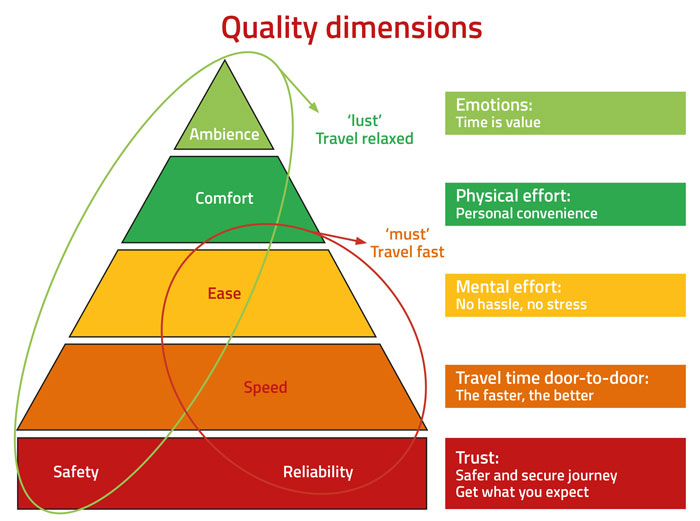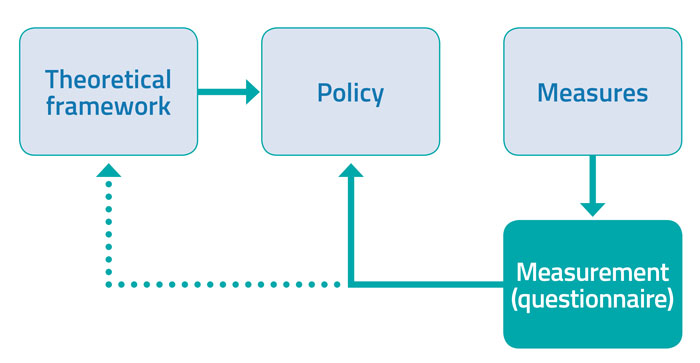Turning a train journey in to a pleasant experience
Posted: 12 April 2018 | Mark van Hagen | No comments yet
In order to attract more passengers onto trains, we must ensure the highest quality journey experience. To provide the best service possible, Netherlands Railways (NS) has committed to placing the customer at the very heart of its mission statement and developed a measuring instrument that enhances the complete train journey experience. Mark van Hagen, Principal Consultant for Customer Experience at NS, discusses this instrument and illustrates its use in a case study.


SEVERAL studies focused on customer needs make it clear that passengers have a steady hierarchy of quality needs. To communicate this to various industry professionals, NS developed an illustrative reference – the ‘Pyramid of Customer Needs’, displayed in Figure 1. The needs that relate to the core business of a train journey are moving and those qualities are shown in the bottom section of the pyramid (safety, reliability, speed and ease). Because being ‘in motion’ is the core business of a train journey, these qualities are known as dissatisfiers; they must be at an acceptable level and service failures will lead to low scores, while an excellent performance leads to, surprisingly, only moderate scores.
When we look at an overall journey, a large proportion of time consists of waiting: Waiting at a station for the train to arrive and waiting on the train until the destination is reached. Waiting passengers are free to use their time in their own way. For Train Operating Companies (TOCs) this presents an opportunity to make passengers happy by creating a comfortable environment; comfortable seats and an appealing ambience. These qualities (comfort and experience) are known as satisfiers. When the elements that make up the satisfiers are performed well, passengers will give high ratings. When satisfiers are performed poorly, you may be surprised to learn that passengers do not actually give low ratings1,2. Based on customer needs, NS has designed a measuring instrument, known as the Train Experience Monitor (TEM), whereby customers score all the relevant quality aspects of a train journey to show how important these factors are to them3,4.


Figure 1: Netherlands Railways’ ‘Pyramid of Customer Needs’
The architecture of an experience questionnaire
To enhance the quality of the service, NS uses the evidence-based design approach. The TEM is at the heart of this management cycle and consists of a short self-completed questionnaire in which passengers are asked to answer various questions about the quality aspects of their train journey5. This questionnaire specifically addresses all the quality layers: For example, it not only features questions related to the functionality of the travel process, such as safety, cleanliness and the provision of information, but also questions related to the overall experience, including levels of comfort and ambience. Policies are then implemented based upon these actual customer insights, leading to targeted improvement changes. The effects of those changes are measured using the TEM tool, so that the degree of improvement can be determined, and the policy adjusted and refined as necessary, as demonstrated in Figure 2.


Figure 2: Learning curve for quality improvement
When aiming to enhance the quality of the journey experience and obtain higher customer ratings, the key is to pay attention to the basic qualities (dissatisfiers) of the train journey. These must be at an acceptable level as a minimum before attention is paid to the satisfiers1.
How does experience work?
People’s behaviour is influenced by numerous stimuli in the environment, often unconsciously. Over 95 per cent of environmental stimuli such as sound, temperature, colour and smell are experienced unconsciously, although they can significantly influence our emotions and therefore our behaviour6. This is illustrated in Figure 3.


Figure 3: Stimulus-Organism-Response model8
The stimuli in the environment can lead to two types of behaviour: Approach or avoidance.
Avoidance behaviour is all the negative behaviour provoked by the environment, i.e. the desire to leave, not wanting to explore, lack of connection with the surroundings and no desire to return.
Approach behaviour is all the positive behaviour provoked by the environment, such as wanting to stay, exploring the surroundings, feeling connected to the place, the desire to spend money and to return. Approach behaviour can be stimulated by carefully selected design and deliberate addition of the right (intangible) stimuli to the environment. This includes, for example, factors such as colours, sounds and smells you might experience during a journey.
Three management dimensions
A train journey is a service; not a product. The difference between a product (e.g. a car) and a service is that the latter is provided and consumed simultaneously. Customers, therefore, find themselves ‘in the factory’ experiencing the service within the physical facilities of the service environment. The environment can therefore be considered as the packaging of the service, which is why it is of such importance in the total customer experience. According to MJ Bitner, the experience of a service can be managed in three interrelated dimensions7:
- The service provision (processes)
- The people present (staff and customers)
- The service environment (place).
The processes have a strongly time-bound nature and efficiency is key: The more efficient and flexible the service provision process, the more satisfied customers will be. The presence of sufficient, competent staff also influences customer satisfaction in a positive sense, as can the numbers and attitudes of other customers in the service environment; too many or too few customers can lead to negative emotions. Finally, the service environment also strongly influences the perception of the service quality. A dirty, chaotic, smelly or noisy environment leads to negative emotions, whereas a clean, inviting and quiet environment leads to positive emotions.
Figure 4 illustrates these three service quality dimensions, which are shown to be interrelated. As seen, the processes take place at the base of the pyramid and the service environment (space) and staff (people) are mainly found on the satisfiers side at the top of the pyramid. The excellent performance of processes leads to satisfied passengers. You can also make your passengers truly happy by offering a perfect service environment with passionate staff.


Figure 4: The three management dimensions of a service
A case study: Modernisation of a double-decker train
Based on customers’ insights, NS has recently modernised an old double-decker unit (VIRM1) and renamed it VIRMm1 (‘m’ stands for modernised). Much attention has been given to the design, with fresh colours and small, yet high-level, details.
Figure 5 demonstrates that the overall average scores are significantly higher for the refurbished unit. The customer evaluations show a considerable increase in the Overall Assessment of Train, Atmosphere and Cleanliness.


Figure 5: Results of the modernisation of an old double-decker train (VIRM1 to VIRMm1)
Importance of quality aspects in a train journey
The Overall Assessment Measurement of a train journey is the final evaluation of the customer experience. A timetable refers to the process, staff to people and train equals the place, as shown in Figure 4. After undertaking statistical (regression) analyses of the data from different train journeys, we discovered that the train itself contributes the most to the overall assessment of the train journey at 60 per cent. This is followed by the contribution of running trains on time at 30 per cent and then staff with 10 per cent. It is obvious that the experience of the train itself has the greatest influence on the Overall Assessment Measurement of the train journey.
References
1. Van Hagen M, De Bruyn M. (2012). The ten commandments of how to become a customer-driven railway operator. European Transport Conference, 8-10 October 2012, Glasgow.
2. Van Hagen M, Foljanty K. (2017). The Quality of a Transport Interchange Through the Eyes of Passengers. In: Journeys, Land Transport Authority, Academy Singapore.
3. Van Hagen M, Peek GJ, Kieft S. (2000). “De functie van het station: een visie”. Colloquium Vervoersplanologisch Speurwerk. Wie betaalt bepaalt, 30 november, 1 december 2000. Delft: CVS.
4. Van Hagen M. (2011). Waiting experience at train stations. Dissertation, Eburon, Delft (NL).
5. Van Hagen M, Sauren J. (2013). Infl uencing the train experience: using a successful measurement instrument. In Elsevier, ETC proceedings 2013.
6. Zaltman G, Coulter RH. (1995). Seeing the Voice of the Customer: Metaphor-Based Advertising Research, Journal of Advertising Research, 35(4), 35-51.
7. Bitner MJ. (1992). Servicescapes: The Impact of Physical Surroundings on Customers and Employees. Journal of Marketing, 56(April), 57-71.
8. Mehrabian, A. & Russell, J.A. (1974). An approach to environment Psychology, Cambridge. MA: Journal of Marketing, 46(2), 86-91.
Biography
MARK VAN HAGEN has been heavily involved in public transport for almost 30 years. He started his career at Amsterdam’s Schiphol Airport as a Researcher. Since 1997 he has been working for Netherlands Railways (NS) as their Principal Consultant for Customer Experience and is responsible for studies on customer demands and developing systems for measuring customer experience. Analysing customer data and advising senior management of NS also comes within his remit. Mark received a distinction from the University of Twente for his dissertation, ‘Waiting Experiences at Train Stations’, completed in April 2011.
Stay Connected with Global Railway Review — Subscribe for Free!
Get exclusive access to the latest rail industry insights from Global Railway Review — all tailored to your interests.
✅ Expert-Led Webinars – Gain insights from global industry leaders
✅ Weekly News & Reports – Rail project updates, thought leadership, and exclusive interviews
✅ Partner Innovations – Discover cutting-edge rail technologies
✅ Print/Digital Magazine – Enjoy two in-depth issues per year, packed with expert content
Choose the updates that matter most to you. Sign up now to stay informed, inspired, and connected — all for free!
Thank you for being part of our community. Let’s keep shaping the future of rail together!







